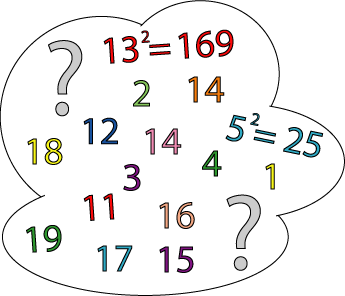Seven square numbers
Problem

Add the sum of the squares of four numbers between $10$ and $20$ to the sum of the squares of three numbers less than $6$ to make the square of another, larger, number.
Getting Started
Make a list of squares of the relevant numbers. Remember that $1$ is a square number.
Student Solutions
Mrs Jopling, a teacher at Heversham St Peter's Primary School sent us this email:
My class have successfully completed the challenge for Seven Square Numbers. 12 children went on the internet in pairs and worked together to find a solution. At the end of the session the children came together for a plenary session and looked at ways of pooling resources to solve the challenge as no group had completed it. Claire worked out that the following numbers squared and added together, then squared gave a whole number: 12 ² + 13 ² + 14 ² + 15 ² + 3 ² + 4 ² + 5 ² = 784Then the square root was 28.
It sounds like a lot of team work went into this solution, well done to you all. Duncan, a student at Balgowan Primary School, Beckenham went about this problem very logically:
First, to work it out, I put the numbers 1,4,9,16,25 and found all the combinations of 3 of those numbers: 14,21,30,26,35,42,29,38,45,50.
I chose a square number 961 and took away all the combinations to make these: 947,940,931,935,926,919,932,923,916,911.
Then I wrote down all the squares where their square roots were between 10 and 20: 100,121,144,169,196,225,256,289,324,361,400.
Afterwards I took the numbers in the 300s (324 and 361) and took them away from the earlier numbers to leave: 611,570,586,607,593,586,623,630,602,565,595,558,608,571,599,562,592,555,587,550.
Then I worked out the combinations of two of the numbers in the 200s added together and they were 481,545 and 514.
I then took away these numbers from the other ones but I realized 545 and 514 ended up with numbers too low even for the lowest square number and taken away from the highest number 611 so I used only 481.
I took this away from 602 to leave 121 and I worked out the answer was: 121+225+256+324+25+9+1=961.
In other words, 11 ² + 15 ² + 16 ² + 18 ² + 5 ² +3 ² +1 ² = 31 ².
Roger at Our Lady's J.M.I. in Welwyn Garden City has come up with a different way although you don't explain how you did it, Roger:
The squares 4,9 and 25 total 38.
The squares of 12, 13, 15 and 18 total 862 add 38 = 900.
The square root of 900 is 30.
Doug has found another solution:
Well done, Doug. If anyone finds another way, do let us know.
Sophie, early in 2016 completed this challenge and arrived at a different solution:I worked out the square numbers less than 6 and the square numbers between 10 and 20. I then worked out some larger square numbers, the numbers between 24 and 38. I added all the different combinations of the sum of the squares of three of 12, 22, 32, 42, 52. I added different combinations of four square numbers between 10 and 20, then subtracted the answer from the next larger square number. I then looked at how much I needed and if it was possible. After a few attempts, I found an answer - 102 +112 +122 +132 +12 +42 +52 = 576 =242
Thank you Sophie, that's great. If anyone finds another way, do let us know.
